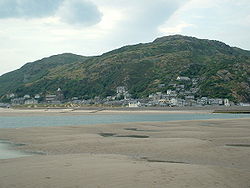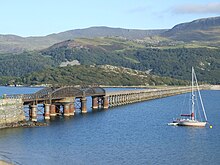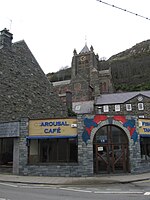Barmouth: Difference between revisions
Created page with '{{Infobox town |name=Barmouth |welsh=Abermaw |county=Merionethshire |picture=Barmouth.jpg |picture caption=Barmouth across the Mawddach estuary |latitude=52.722 |longitude=-4.055…' |
m clean up, typos fixed: aroud → around |
||
| (One intermediate revision by one other user not shown) | |||
| Line 42: | Line 42: | ||
==The Barmouth Three Peaks race== | ==The Barmouth Three Peaks race== | ||
The Barmouth to Fort William Three Peaks Yacht Race is a famous fixture on the yachting calendar, held every year and attracting crews and boats from the | The Barmouth to Fort William Three Peaks Yacht Race is a famous fixture on the yachting calendar, held every year and attracting crews and boats from the around the world. It is described as "a unique event combining sailing running and a little cycling that has become one of the toughest distance events in the world".<ref>[http://www.threepeaksyachtrace.co.uk/ Three Peaks]</ref> | ||
The race involves sailing from Barmouth to climb each of the highest mountains in Wales, England and Scotland. The yachts set sail first for [[Caernarfon]] and the climbers of the crew then scale [[Snowdon]]. Then they sail north to [[Whitehaven]] and unload bicycles (the only stage at which bicycles are permitted) and climb [[Scafell Pike]]. Returning to the boats, the crews sail for [[Fort William]] and climb [[Ben Nevis]], the highest of them all. | The race involves sailing from Barmouth to climb each of the highest mountains in Wales, England and Scotland. The yachts set sail first for [[Caernarfon]] and the climbers of the crew then scale [[Snowdon]]. Then they sail north to [[Whitehaven]] and unload bicycles (the only stage at which bicycles are permitted) and climb [[Scafell Pike]]. Returning to the boats, the crews sail for [[Fort William]] and climb [[Ben Nevis]], the highest of them all. | ||
| Line 62: | Line 62: | ||
*[http://www.gtj.org.uk/en/item1/11338 Aerial photograph of Barmouth] | *[http://www.gtj.org.uk/en/item1/11338 Aerial photograph of Barmouth] | ||
*[http://www.geograph.org.uk/search.php?i=3491048 www.geograph.co.uk : photos of Barmouth and surrounding area] | *[http://www.geograph.org.uk/search.php?i=3491048 www.geograph.co.uk : photos of Barmouth and surrounding area] | ||
[[Category:Seaside resorts in Merionethshire]] | |||
Latest revision as of 13:39, 28 January 2016
| Barmouth Welsh: Abermaw | |
| Merionethshire | |
|---|---|
 Barmouth across the Mawddach estuary | |
| Location | |
| Grid reference: | SH613158 |
| Location: | 52°43’19"N, 4°3’18"W |
| Data | |
| Population: | 2,230 |
| Post town: | Barmouth |
| Postcode: | LL42 |
| Dialling code: | 01341 |
| Local Government | |
| Council: | Gwynedd |
| Parliamentary constituency: |
Dwyfor Meirionnydd |
Barmouth is a town in Merionethshire, a holiday resort standing on the open sea of Cardigan Bay and on the broad estuary of the River Mawddach.
The town is served by Barmouth railway station, which was the foundation and fortune of the town, and the reason for its most spectacular sight: the Barmouth Bridge stretching half a mile across the sands and waters.
The town's Welsh name is Abermaw formally ("Maw-mouth", from the Mawddach), but colloquially it is called Y Bermo, in imitation of the English name.
The town
The town grew around the shipbuilding industry, and more recently as a seaside resort. Notable buildings include the mediæval Tŷ Gwyn tower house, the 19th century Tŷ Crwn roundhouse prison and St John's Church. There is also a new RNLI Lifeboat Visitors' Centre, with its own souvenir shop and a viewing gallery from which visitors may look at the lifeboat.
The busy harbour plays host to the annual Three Peaks yacht race. The famous mountaineer and sailor Bill Tilman, whose adventures and tales were the inspiration for the race, lived in Barmouth for many years.

Barmouth Bridge, which takes the Cambrian Line over the River Mawddach, was also once at the end of the Great Western Railway's Ruabon Barmouth line, which passed through Bala and Dolgellau. The southern end of the bridge is now the start of the Mawddach Trail, a cycle path and walkway that uses the old trackbed. The bridge stretches for half a mile across the tidal sands, providing a marvellous vista over the estuary and the town. A footbridge is incorporated on the upstream side, with a toll of 70 pence.
Ferries sail from Barmouth to Penrhyn Point, where they connect with the narrow gauge Fairbourne Railway for the village of Fairbourne.
Resort town
William Wordsworth, a visitor to Barmouth in the 19th century, described it thus:
| “ | With a fine sea view in front, the mountains behind, the glorious estuary running eight miles inland, and Cadair Idris within compass of a day's walk, Barmouth can always hold its own against any rival. | ” |
Barmouth is geographically the closest seaside resort to the Black Country towns and Birmingham and a large proportion of its tourist visitors and permanent residents, are from thoe parts.

One of Barmouth's star attractions for the last 25 years or so has been the Arousal Café. Originally the 'Carousal Café', the letter C was stolen soon after the sign was put up. The owner replaced the C numerous times, only to find it stolen again. He has since ceased his attempts to fix the sign.
The Barmouth Three Peaks race
The Barmouth to Fort William Three Peaks Yacht Race is a famous fixture on the yachting calendar, held every year and attracting crews and boats from the around the world. It is described as "a unique event combining sailing running and a little cycling that has become one of the toughest distance events in the world".[1]
The race involves sailing from Barmouth to climb each of the highest mountains in Wales, England and Scotland. The yachts set sail first for Caernarfon and the climbers of the crew then scale Snowdon. Then they sail north to Whitehaven and unload bicycles (the only stage at which bicycles are permitted) and climb Scafell Pike. Returning to the boats, the crews sail for Fort William and climb Ben Nevis, the highest of them all.
The race has 389 sea miles in treacherous coastal waters, 26 miles by bicycle and 72 miles on foot, climbing 14,000 feet. The race record stands at 2 days 14 hours and 4 minutes.
References

Outside links
| ("Wikimedia Commons" has material about Barmouth) |
- Barmouth community website
- Barmouth.org
- Mawddachestuary.co.uk What's on in Barmouth
- Illustrated Guide to Barmouth
- Sunset at Barmouth and Barmouth Evening by Christopher Williams, painted in 1910s and exhibited at National Library of Wales.
- Aerial photograph of Barmouth
- www.geograph.co.uk : photos of Barmouth and surrounding area
